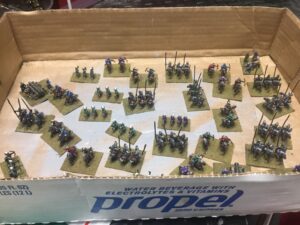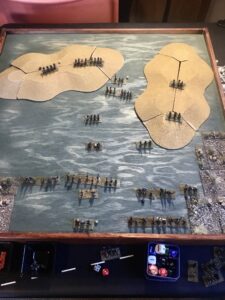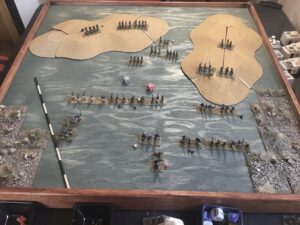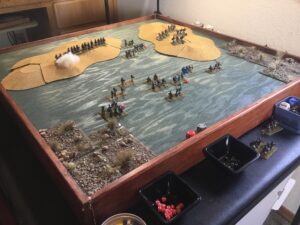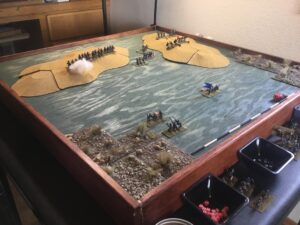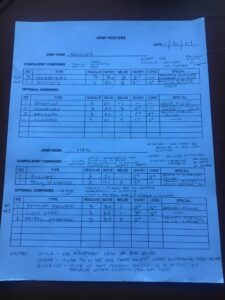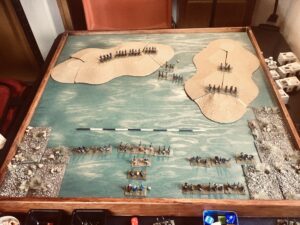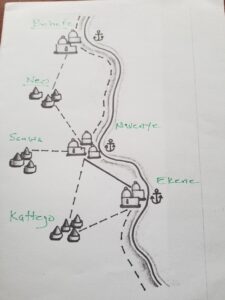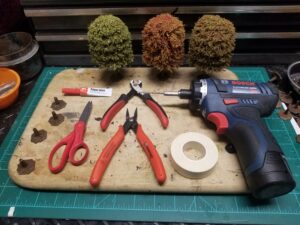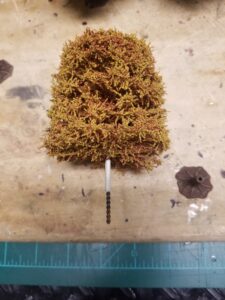I have a newfound admiration for gamers publishing quality After Action Reports (AARs). I lack the discipline and ability to a) systematically record what occurred and b) take quality photos to document the ebb and flow of the game.
My (weak and convenient) excuse is that I get all wrapped up in gameplay.
So, what follows is a semi-coherent, poorly documented account of The Action(s) at Sanwa.
It’s plural because I played the scenario twice. As discussed in an earlier post, I was not satisfied by my adherence to the rules, and wanted to try again.
Both games had the same outcome: A resounding Kattegoan defeat. By design, the circumstances were similar. By this, I mean that each side employed the same tactics in both games. Again, the purpose of the replay was to get better with implementing the rules.
In that regard, the second game was a success.
The battlefield featured several areas of rough terrain, and a small hill dominating the west. North is at the top of the photo. The measuring stick has 40mm (company frontage) increments (referred to as units in RAW).
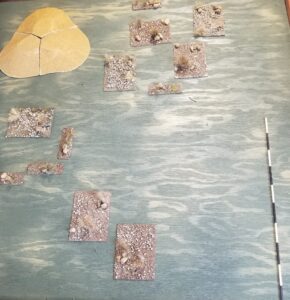
As defenders, the Sanwanians deployed first, with two Companies of Archers on the small hill, four Companies of Archers deployed just north of the rough terrain in the center, and with all warrior companies to the east, and deployed in depth. The Lord’s Company was positioned in the center along with one Company of Slavers.
The attacking Kattegoans reacted with a similar deployment. Two Companies of Scouts holding down the left (west) flank, with three Companies of Archers and two Companies of Warriors in the center, with all others on the right flank.
A quick tactical note: Deployment in depth is trickey. Rules As Written (RAW) has a Wavering company (Resolve at one (1)) immediately retiring one (1) D3 movement units (in this game a unit=40mm) to its immediate rear. Any Company it comes in contact with (there is no interpenetration in these rules) immediately loses one (1) Resolve. If a unit reaches a Resolve of Zero (0), it Scatters. Any Company within two (2) movement units immediately loses one (1) Resolve. Companies stacked up and with low Resolve can literally evaporate in a single turn. This is absolutely critical when Companies (as is the case with Tribal Warriors) start with a Resolve of only three (3), and maybe at two (2), if effected by Disease.
Both sides moved out of their deployment areas, crossed their respective lines of departure, and began exchanging ineffective missile fire. Yes, some Companies took significant enough losses to retire, but they were quickly rallied and moved back to their original positions.
The Warriors of each side advanced towards each other, but stayed beyond charge distance hoping for a favorable outcome in the lengthy missile exchange. The Kattegoans lost patience and moved within charge range (Three (3) Units) of their opponents. They gambled on gaining the initiative for the next turn (“Lord” Oumar being an Experienced Lord with a +1D6 modifier when rolling for initiative). If so, they could charge and receive a +1 D6 combat modifier. It was not to be. The Sanwanians rolled higher, and attacked.
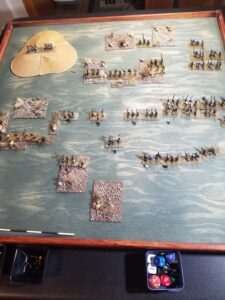
Both sides were locked in melee for several turns. Melee in Irregular Wars is decided by comparative 1xD6 rolls. If the difference in rolls is one (1) or two (2), the units remain engaged. If the difference is three (3) to six (6), the loser suffers a loss in Resolve. If greater than six (6), a loss of two (2) Resolves. Now here is where things get interesting…..a tie results in a “Bloody Draw”, where both sides lose one (1) Resolve.
As mentioned above, when a Company reaches one (1) Resolve, it Wavers, and must withdraw 1xD3 units directly to the rear. In a “Bloody Draw” with Companies at a one (1), both Companies have to withdraw. This creates a battlefield that cannot be characterized as “tidy”, and accounts for the seeming absence of linear frontages for both sides.
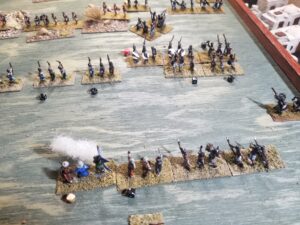
After as series of melees, the Kattegoans buckled (the Sanwanian Warriors have shields – well all except one Company). Simultaneously, the Sanwanians moved reserves to engage the Kattegoan Archers.
Quick Note: The cotton “smoke” indicates a firearm equipped Company has fired and has yet to reload. Reloading takes one turn’s Action Phase. In this photo, the firing Company includes Lord Oumar, who subsequently became very busy using his Company’s Action Phase to rally his Wavering Companies. His Company took several turns rallying companies before it reloaded.
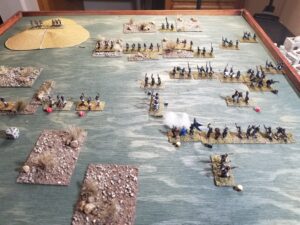
Oumar’s efforts were effective as his threatened flank stabilized. A Pious Company (with the ability to rally due to their strong religious beliefs – and designated with a gold cube) is shown moving behind the Kattegoans in order to support the left flank.
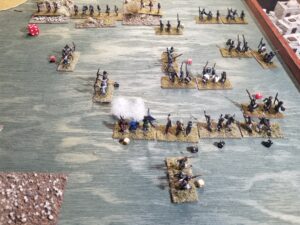
The Sanwanians maintained their pressure on the Kattegoan right flank, pushing through resistance as the Kattegoan archers continue to be disrupted by missile fire and a flank attack.
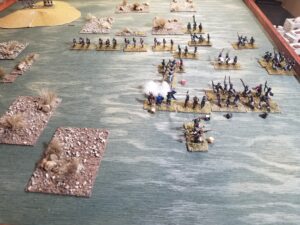
As the Sanwanian Archers moved forward to support the final assault, the Kattegoan flank collapsed. Only a few companies were able to flee the field without Scattering.
End Game here was very similar to the first battle. Here’s a few pictures of those final stages of Game Number One.
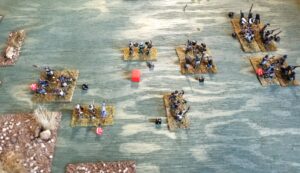
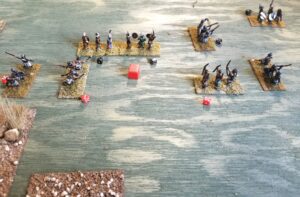
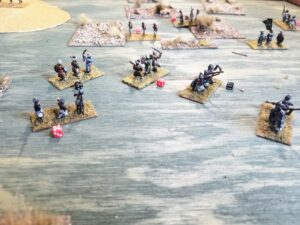
In this sequence, what remained of the Kattegoan right flank/center were hemmed in, and attempted a retreat to the Northwest. It is doubtful their pursuers will take the fleeing Slavers alive.were pursued by the Sanwanians.
Good, fun solitaire game with twists and turns. Not for the Gamer looking for total control.
Now I have figure out the ramifications of this stunning victory.
